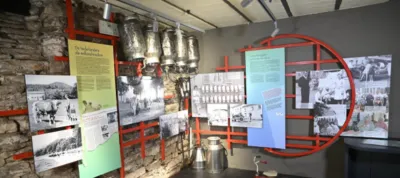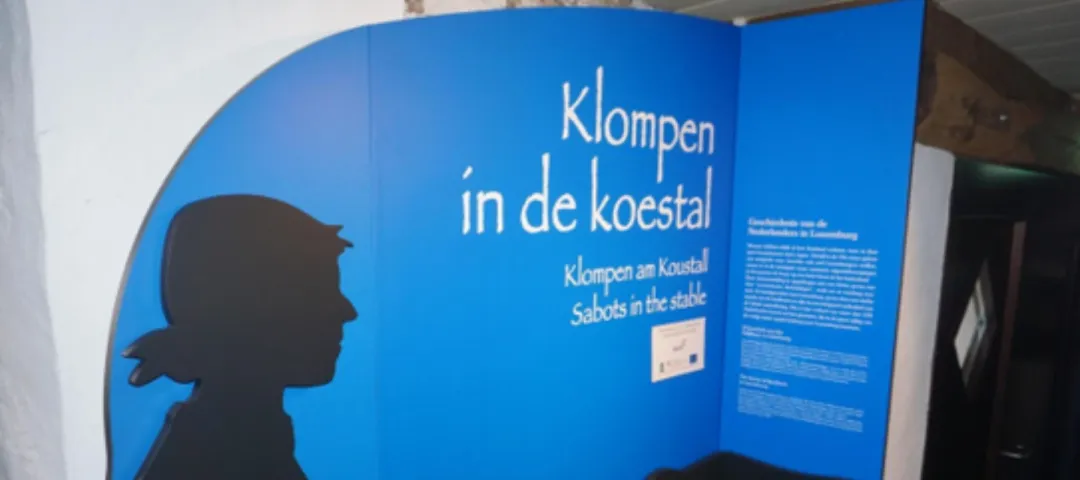General information
RDP Priority
- P6. Social inclusion and local development
RDP Focus Area
- 6B: Local development
RDP Measure
- M19: LEADER/CLLD
Beneficiary type
- Non-profit organisation
Summary
The promotion of tourism activities to support regional development is a thematic priority of the development strategy of the Éislek region LEADER Local Action Group (LAG). By developing a new exhibition at a local museum, the overall visitor offer has been improved through the addition of quality indoor activities. This provides the kind of bad-weather and off-peak activity option that is often lacking in rural regions like Éislek that specialise in nature-based tourism.
Also, in line with the strategic objective of promoting regional identity, the project brought to life a lesser-known aspect of local history: the immigration of Dutch farmers to Luxembourg during the 1950s. Many innovative farming practices were brought to the region by these families, and the fact that the Luxembourg farm sector is so invested in milk production today is in large part thanks to their arrival and successful integration.
Results
- The exhibition paints a compelling picture through a combination of first-person narratives, oral testimonies and personal items, even providing an interactive database that traces the origin and destination of families that migrated to Luxembourg, based on their Dutch family names.

Promoter
Syndicat d’intérêts Binsfeld-Holler-Breidfeld
Funding
Total budget: 43 861 (EUR)
EAFRD: 18 685 (EUR)
National/Regional: 12 456 (EUR)
Private/own: 12 720 (EUR)
Ressourcen
Links
Context
During the 1950s, around 150 Dutch farming families migrated to Luxembourg, driven by a shortage of farmland in the Netherlands and the availability of agricultural land in the Grand Duchy. These families successfully integrated into rural Luxembourgish society and significantly influenced local farming practices by introducing new methods and crop varieties.
Until recently, however, their stories had remained largely undocumented. With the gradual passing of the post-World War II generation, many oral testimonies from that era risk being lost forever.
This LEADER project supported crucial archival efforts to preserve this fading legacy. It enabled the collection of previously unrecorded historical knowledge and led to the creation of a permanent exhibition on Dutch immigration at the Rural Museum in Binsfeld. The project not only enhanced the quality of local indoor tourism but also helped valorise aspects of the Éislek region’s cultural heritage for both residents and visitors.
Objectives
The aims of this project were to:
- Expand the museum’s collection through a thematic exhibition titled ‘Klompen in de Koestal’ (Dutch for ‘Clogs in the stable’), focusing on the history of Dutch farmer immigration to Luxembourg.
- Research, document and present the migration story by addressing key questions such as: What caused the immigration? What did the farmers bring with them? How did they integrate into rural society? What traces of their presence remain today? The exhibition seeks to shed light on this example of successful migration history.
- Broaden the offerings of the existing Musée Rural Binsfeld (French for Rural Museum in Binsfeld), which presents daily life in rural communities through a carefully curated exhibit.
Activities
Project activities included:
- Gathering and archiving the material for the exhibition through many exchanges with Dutch/Luxembourgish families and an association representing Dutch farmers in Luxembourg.
- Collecting personal stories, documents, tangible and intangible remnants and pictures, then curating them within the exhibit to communicate different aspects of this nearly forgotten part of Luxembourg’s rural history.
- Designing and setting up the exhibition about rural immigration in Luxembourg.
Main results
- ‘Klompen in de Koestal’ takes the visitor on a journey back to the 1950s, showcasing the situation back then in Luxembourg and the Netherlands. The reasons for the immigration are illustrated, as well as the various necessary administrative and private preparations that families made before their journeys, and the problems they encountered. Different waves of migration are charted, as is the story of how these families integrated into their new lives, as well as the role of religion and the exchange of farming practices. Indeed, the story is told in detail from the beginning, right to the present day.
- A separate room has been dedicated to the special exhibition, which expands the museum’s offer, informing visitors about the history and everyday life of rural populations.
Key lessons
- The project gathered and highlighted parts of the unique history of the Éislek region, providing an example for other LAGs to engage with their region’s history and heritage through a similar approach, both to strengthen and deepen understanding of regional identity and to increase the number of cultural tourism activities. Ultimately, the project illustrates that with a limited budget but a clear view of a project’s objective, a high-quality result can be achieved.
Ever wondered why so many Luxembourgish families have Dutch surnames? The answer to this can be found when visiting the permanent exhibition in the Rural Museum in Binsfeld. It highlights and helps to understand a significant historical connection between the Netherlands and Luxembourg, showcasing the benefits of intercultural exchange and exchange of knowledge.
Fred Huet

